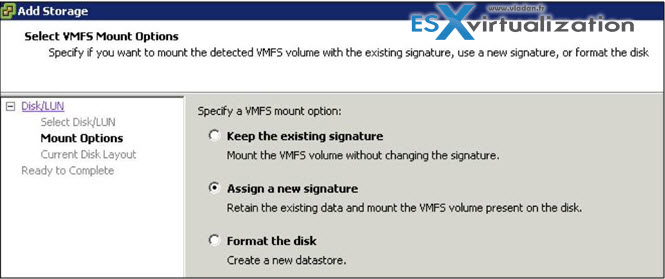You can resignature a disk by using the vSphere Client or using the command line. vSphere client gave me no results recently, but normally it’s very easy. You just do it when you firstselect your host > configuration > storage > add storage > chose disk/lun > and choose the option you want.
Select Assign new signature or keep existing signature, depending on your needs, and click next, next …
Using ESXCLI
We can list all detected VMFS snapshot volumes with the following command, even if for some reason we aren’t able to mount the volume from within vSphere client (it was my case in a lab recently…).
This command will list the names of the VMFS datastores and their UUIDs.
esxcfg-volume –l
As you can see in our case we have the output like this:
Choose either:
esxcfg-volume –r
to resignature the volume. The general syntax is following:
esxcli storage vmfs snapshot resignature –volume-label=<label>|–volume-uuid=<id>
OR use the “M” switch (note it’s a Capital M) to mount the volume as is (keep existing signature):
esxcfg-volume –M
to mount the volume without resignaturing (use lower case m for temporary mount rather than persistent).
Yes, if you do not wish the volume mount to persist a reboot, the -m switch shall be used instead.
source:http://www.vladan.fr/mount-vmfs-datastore/

